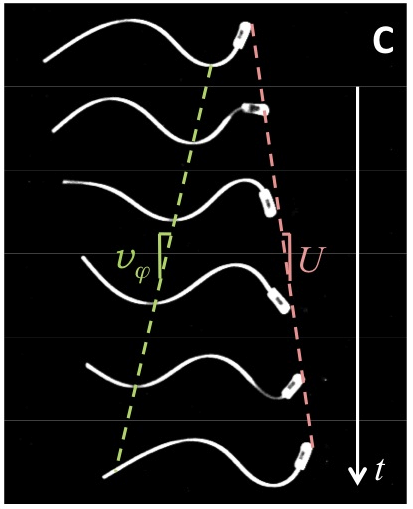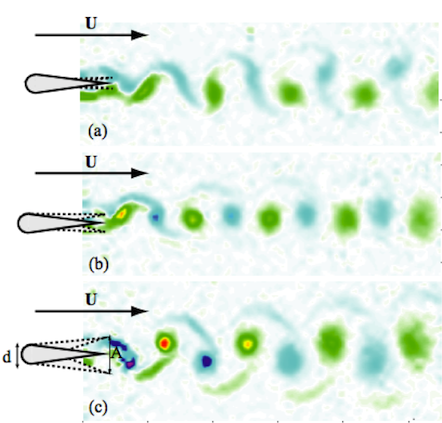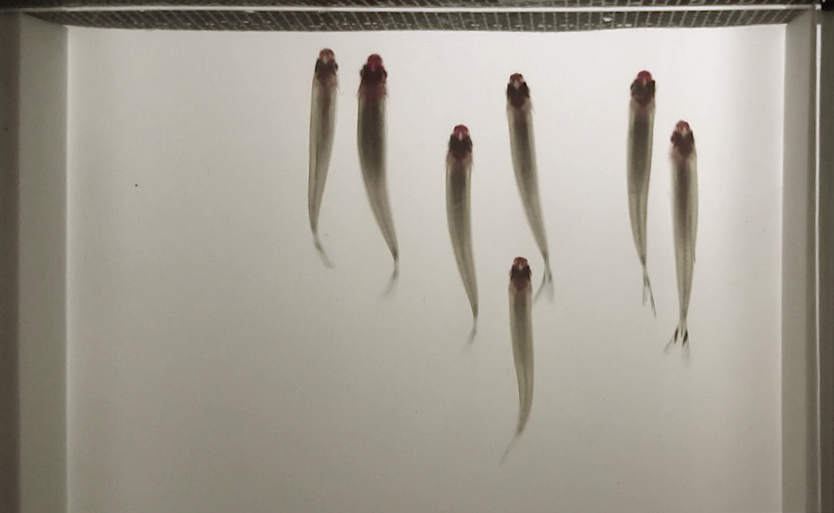Congratulations Baptiste & Vincent for your great videos!
V0078: Swimming snakes vortices highlighted with volumetric velocimetry
https://doi.org/10.1103/APS.DFD.2021.GFM.V0078
V0033: To see or not to see : on the role of light in fish schooling
https://doi.org/10.1103/APS.DFD.2021.GFM.V0033
Synchronized Side-by-Side Swimmers
On the fluid dynamical effects of synchronization in side-by-side swimmers
R. Godoy-Diana, J. Vacher, V. Raspa & B. Thiria
Biomimetics 4(4), 77 (2019)
https://doi.org/10.3390/biomimetics4040077
(in the Special issue “Fluid Dynamic Interactions in Biological and Bioinspired Propulsion”, Editors K. W. Moored and G. V. Lauder)
We examined experimentally the in-phase and anti-phase synchronized swimming of two self-propelled independent flexible foils swimming side-by-side in a water tank. The foils are actuated by pitching oscillations at one extremity—the head of the swimmers—and the flow engendered by their undulations is analyzed using two-dimensional particle image velocimetry in their frontal symmetry plane. Following recent observations on the behavior of real fish, we focus on the comparison between in-phase and anti-phase actuation by fixing all other geometric and kinematic parameters. We show that swimming with a neighbor is beneficial for both synchronizations tested, as compared to swimming alone, with an advantage for the anti-phase synchronization. We show that the advantage of anti-phase synchronization in terms of swimming performance for the two-foil “school” results from the emergence of a periodic coherent jet between the two swimmers.
Synchronisation and pattern formation in fish swimming
Simple phalanx pattern leads to energy saving in cohesive fish schooling
I. Ashraf, H. Bradshaw, T. T. Ha, J. Halloy, R. Godoy-Diana, B. Thiria
PNAS 114 (36) 9599-9604 (2017)
[doi:10.1073/pnas.1706503114]
Synchronisation and collective swimming patterns in Hemigrammus bleheri
I. Ashraf, R. Godoy-Diana, J. Halloy, B. Collignon, B. Thiria
Journal of the Royal Society Interface 13 20160734 (2016)
[doi:10.1098/rsif.2016.0734] 
The question of how individuals in a population organize when living in groups arises for systems as different as a swarm of microorganisms or a flock of seagulls. The different patterns for moving collectively involve a wide spectrum of reasons, such as evading predators or optimizing food prospection. Also, the schooling pattern has often been associated with an advantage in terms of energy consumption. We use a popular aquarium fish, the red nose tetra fish, Hemigrammus bleheri, which is known to swim in highly cohesive groups, to ana- lyze the schooling dynamics. In our experiments, fish swim in a shallow-water tunnel with controlled velocity, Continue reading “Synchronisation and pattern formation in fish swimming”
Elastic swimmer on a free surface
Elastic swimmer on a free surface
S. Ramananarivo, B. Thiria & R. Godoy-Diana.
Physics of Fluids, 26: 091112 (2014)
[doi:10.1063/1.4893539]
*31st Annual Gallery of Fluid Motion (Pittsburgh, Pennsylvania, USA, 2013)
Passive elastic mechanism to mimic fish-muscles action in anguilliform swimming
 Passive elastic mechanism to mimic fish-muscles action in anguilliform swimming
Passive elastic mechanism to mimic fish-muscles action in anguilliform swimming
S. Ramananarivo; R. Godoy-Diana & B. Thiria.
Journal of the Royal Society Interface 10 : 20130667 (2013).
Abstract: Swimmers in nature use body undulations to generate propulsive and maneuvering forces. The an- guilliform kinematics is driven by muscular actions all along the body, involving a complex temporal and spatial coordination of all the local actuations. Such swimming kinematics can be reproduced artificially, in a simpler way, by using passively the elasticity of the body. Here we present experiments on self-propelled elastic swimmers at a free surface in the inertial regime. Continue reading “Passive elastic mechanism to mimic fish-muscles action in anguilliform swimming”
Bending to fly
How wing compliance drives the efficiency of self-propelled flapping flyers
B. Thiria & R. Godoy-Diana.
Physical Review E, 82 : 015303(R) (2010).
*arXiv preprint blogged in MIT Technology Review (March 2, 2010)
*Also referenced in Vir. J. Bio. Phys. Res. / Volume 20 / Issue 3 / (August 1, 2010)
Abstract: Wing flexibility governs the flying performance of flapping-wing flyers. Here, we use a self-propelled flapping-wing model mounted on a ”merry go roun” to investigate the effect of wing compliance on the propulsive efficiency of the system. Continue reading “Bending to fly”
Transitions in the wake of a flapping foil
 Transitions in the wake of a flapping foil
Transitions in the wake of a flapping foil
R. Godoy-Diana; J. L. Aider & J. E. Wesfreid.
Physical Review E, 77 : 016308 (2008).
Abstract: We study experimentally the vortex streets produced by a flapping foil in a hydrodynamic tunnel, using two-dimensional particle image velocimetry. An analysis in terms of a flapping frequency-amplitude phase space allows the identification of (i) the transition from the well-known Bénard-von Kármán (BvK) wake to the reverse BvK vortex street that characterizes propulsive wakes, and (ii) the symmetry breaking of this reverse BvK pattern giving rise to an asymmetric wake. Continue reading “Transitions in the wake of a flapping foil”
Internal gravity waves in a dipolar wind
Internal gravity waves in a dipolar wind: a wave–vortex interaction experiment in a stratified fluid
R. Godoy-Diana; J. M. Chomaz & C. Donnadieu.
Journal of Fluid Mechanics, 548 : 281-308 (2006).
Abstract: An experimental study on the interaction of the internal wave field generated by oscillating cylinders in a stratified fluid with a pancake dipole is presented. The experiments are carried out in a salt-stratified water tank with constant Brunt–Väisälä frequency ($N$). Experimental observations of the deformation of the wave beams owing to the interaction with the dipole are presented. Continue reading “Internal gravity waves in a dipolar wind”

